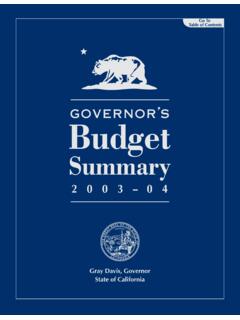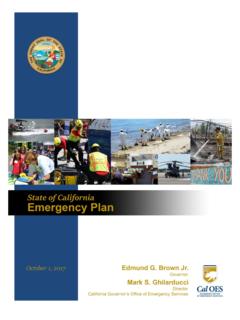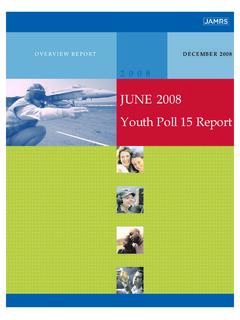Transcription of (Page intentionally blank.) - cpuc.ca.gov
1 (Page intentionally blank.) 2013 Senate Bill 695 Report CPUC Actions to Limit Utility Costs Page i Contents I. EXECUTIVE SUMMARY .. 1 A. STATUTORY MANDATE .. 1 B. CHALLENGES .. 1 C. STRUCTURE OF REPORT .. 2 II. ELECTRIC UTILITY COSTS AND REVENUE REQUIREMENTS .. 3 A. REQUESTS FOR REVENUE REQUIREMENT INCREASES UNDER CPUC CONSIDERATION .. 4 B. PLANS TO IMPROVE CPUC EFFICACY IN RATEMAKING .. 6 C. OTHER RATE RELATED PROCEEDINGS IN THE NEXT 12 MONTHS .. 7 III. PROGRAM-SPECIFIC PROCEEDINGS AND ACTIVITIES .. 8 A. RESOURCE ADEQUACY AND LONG TERM PROCUREMENT .. 8 B. RENEWABLES PORTFOLIO STANDARD .. 12 C. EMERGING PROCUREMENT STRATEGIES .. 15 D. ENERGY EFFICIENCY .. 18 E. DEMAND RESPONSE .. 21 F. RATE DESIGN AND TIME-VARYING PRICING .. 22 G. CUSTOMER-SITED DISTRIBUTED GENERATION AND CALIFORNIA SOLAR INITIATIVE.
2 32 H. ENERGY SAVINGS ASSISTANCE .. 34 I. CPUC ADVOCACY FOR CALIFORNIA ELECTRIC INTERESTS AT FERC .. 35 IV. NATURAL GAS RATES AND COSTS .. 37 A. CPUC ACTIONS TO LIMIT GAS COST AND RATE INCREASES .. 38 B. CPUC ADVOCACY FOR CALIFORNIA NATURAL GAS INTERESTS AT FERC .. 41 V. APPENDIX .. 42 UTILITY REPORTS ON RECOMMENDED MEASURES TO LIMIT COSTS AND RATE INCREASES .. 42 A. PACIFIC GAS AND ELECTRIC COMPANY .. 43 B. SOUTHERN CALIFORNIA EDISON COMPANY .. 65 C. SOUTHERN CALIFORNIA GAS COMPANY .. 76 D. SAN DIEGO GAS AND ELECTRIC 90 (Page intentionally blank.) 2013 Senate Bill 695 Report CPUC Actions to Limit Utility Costs Page 1 I. Executive Summary A. Statutory Mandate The California Public Utilities Commission (CPUC) regulates investor-owned electric and natural gas utilities within the State of California, including Pacific Gas and Electric Company (PG&E), Southern California Edison Company (SCE), San Diego Gas and Electric Company (SDG&E), and Southern California Gas (SoCal Gas).
3 These utilities serve over two-thirds of total electricity demand and over three-quarters of natural gas demand throughout The CPUC develops and administers energy policies and programs to serve the public interest, oversees compliance with statutory mandates, and promotes reliable, safe and environmentally sound energy services at the lowest reasonable rates for the people of California. Section 748 states: 748. (a) The commission, by May 1, 2010, and by each May 1 thereafter, shall prepare and submit a written report, separate from and in addition to the report required by Section 747, to the Governor and Legislature that contains the commission s recommendations for actions that can be undertaken during the succeeding 12 months to limit utility cost and rate increases, consistent with the state s energy and environmental goals, including goals for reducing emissions of greenhouse gases.
4 (b) In preparing the report required by subdivision (a), the commission shall require electrical corporations with 1,000,000 or more retail customers in California, and gas corporations with 500,000 or more retail customers in California, to study and report on measures the corporation recommends be undertaken to limit costs and rate increases. (c) The commission shall post the report required by subdivision (a) in a conspicuous area of its Internet Web site. The 2013 edition of this report is hereby submitted by the CPUC to the Governor and Legislature. B. Challenges Perhaps the greatest challenge facing the CPUC is apparent in the above language of the law: to limit utility cost and rate increases, consistent with the state s energy and environmental goals . The least-cost methods of producing and delivering electricity and gas to customers, if one considers only direct, short-run costs, are often not the cleanest, safest, or most reliable methods.
5 California has made many separate decisions over the past decades in consideration of the costs imposed by health effects of producing and delivering energy, and its lawmakers have embedded such decisions in a number of state legal codes, including the Public Utilities 1 In addition to the four large utilities, the CPUC also regulates a number of small and multi-jurisdictional energy utilities; however, these utilities are not subject to the reporting requirements of Public Utilities Code Section 748. 2013 Senate Bill 695 Report CPUC Actions to Limit Utility Costs Page 2 Code. Striking a balance between competing and sometimes conflicting legislated and judicially ordered goals and procedures is the daily work of the CPUC. Another challenge in developing this report as mandated is the fact that the content is necessarily limited by the quasi-judicial nature of the agency, which makes formal decisions based on evidence presented by the parties involved.
6 A CPUC report must be careful to not prejudge issues that are the subject of open cases, since to do so could interfere with due process. Working within this limitation, this report describes the policies the CPUC already has recommended or chosen to limit utility cost and rate increases while addressing the state s energy and environmental goals. The report also describes many areas where the implementation of adopted policies is undergoing further examination or revision to improve the efficacy or efficiency of the policy or program delivery. C. Structure of Report This report consists of four main parts. First, the report discusses the electric utilities annual proposed or recently adopted revenue requirements to provide service. The CPUC reviews these requests in General Rate Case (GRC) and Energy Resource Recovery Account (ERRA) proceedings.
7 This section provides the Legislature a snapshot of the scope and financial implications of the proceedings and how the CPUC reviews proposals with the goal of limiting costs and rate increases. Then the report describes programs the CPUC uses to promote reliable, robust, low-risk, and low-cost electricity strategies, and to advance the State s environmental and public purpose goals. To better determine the efficacy of its programs and to determine whether ratepayers benefit from the programs, the CPUC conducts a variety of benefit-cost studies. Next, the report addresses the same issues for the natural gas utilities. Lastly, the report contains an appendix of utility submissions detailing their future revenue requirements, demand forecasts, pending and anticipated proceedings, and recommendations to limit costs and rate increases.
8 2013 Senate Bill 695 Report CPUC Actions to Limit Utility Costs Page 3 II. Electric Utility Costs and Revenue Requirements Utilities file detailed descriptions of the costs of providing service (commonly referred to as revenue requirements to be collected from customers) in various proceedings and request the CPUC to approve their proposed revenue requirement. The CPUC strives to balance the electric utility customers needs for safe, reliable, and environmentally responsible service and the utilities financial health, while achieving the lowest possible rates. Since energy services are essential, the CPUC ensures that access is universal and affordable. The bulk of utility revenue requirement is requested in General Rate Cases (GRCs) and the Energy Resource Recovery Account (ERRA) proceedings.
9 GRCs address a utility s revenue requirement for maintaining and enhancing their generation and distribution infrastructure. ERRA costs are primarily fuel and purchased power costs which carry no mark-up or rate of return for the utility. In addition to the GRCs and ERRA proceedings, some costs are requested by the utilities in specific proceedings related to program areas such as energy efficiency, renewables portfolio standard (RPS), California Solar Initiative (CSI), distributed generation (DG) and demand response (DR), which are described in other chapters of this report. Table II-1 Total Authorized Electric Revenue Requirements effective January 1, 2013 ($ Million) PG&E SCE SDG&E $12,370 $12,015 $3,141 The utilities file GRC applications every three or four years. CPUC decisions on utilities GRC applications establish revenue requirements for an initial forecast year (test year), and two or three subsequent attrition years to account for cost escalation during the GRC cycle.
10 PG&E, SCE, and SDG&E file ERRA forecast applications annually to recover fuel and purchased power costs expected during a future annual period. Each utility also files an annual ERRA compliance application to address actual ERRA costs incurred during a prior annual period. The ERRA proceedings were established by the CPUC in 2002 in response to AB 57 (2001), which required that the utilities receive timely recovery of their electricity procurement costs. All of the CPUC-approved GRC and ERRA costs are recovered through two main types of rate charges -- generation and distribution -- which appear on customer bills as separate line items. Transmission-related costs and revenue requirements are under the jurisdiction of the Federal Energy Regulatory Commission (FERC) and are recovered in the transmission component of rates.
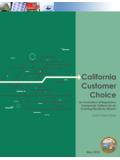



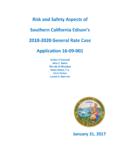


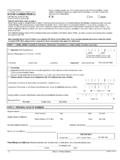

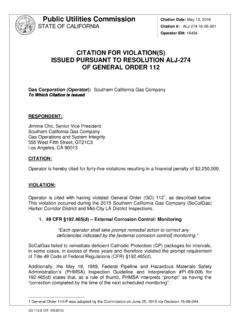
![[Page Intentionally Blank] - Police Executive …](/cache/preview/6/9/5/6/0/0/0/f/thumb-6956000f3f6abdc7d6fe85fa330b8ad5.jpg)



